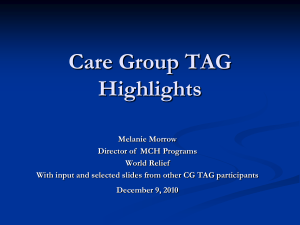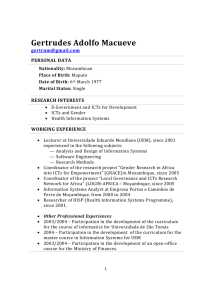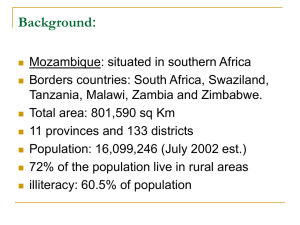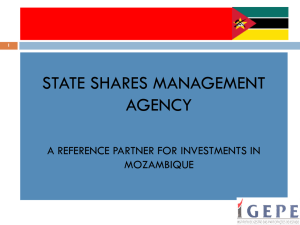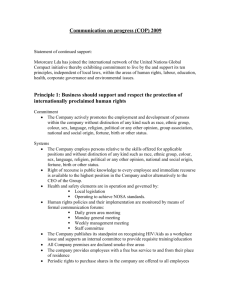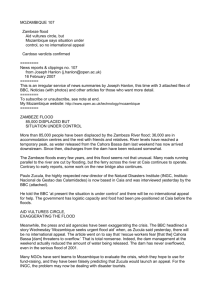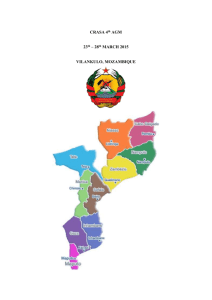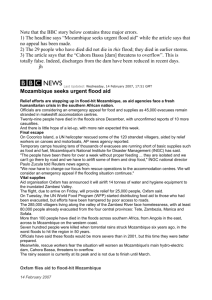Staff Paper A BRIEF OVERVIEW OF MOZAMBIQUE’S
advertisement
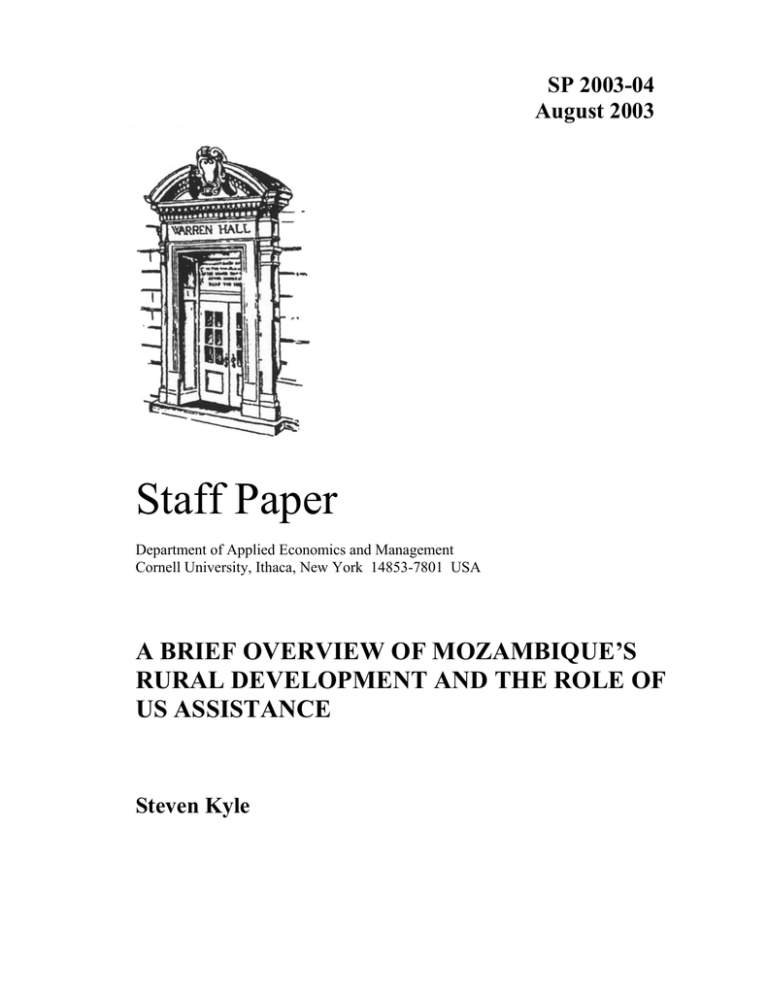
SP 2003-04 August 2003 Staff Paper Department of Applied Economics and Management Cornell University, Ithaca, New York 14853-7801 USA A BRIEF OVERVIEW OF MOZAMBIQUE’S RURAL DEVELOPMENT AND THE ROLE OF US ASSISTANCE Steven Kyle It is the Policy of Cornell University actively to support equality of educational and employment opportunity. No person shall be denied admission to any educational program or activity or be denied employment on the basis of any legally prohibited discrimination involving, but not limited to, such factors as race, color, creed, religion, national or ethnic origin, sex, age or handicap. The University is committed to the maintenance of affirmative action programs which will assure the continuation of such equality of opportunity. 2 A BRIEF OVERVIEW OF MOZAMBIQUE’S RURAL DEVELOPMENT AND THE ROLE OF US ASSISTANCE Steven Kyle Cornell University Presented to the National Intelligence Council Conference on Mozambique August 7, 2003 4 A BRIEF OVERVIEW OF MOZAMBIQUE’S RURAL DEVELOPMENT AND THE ROLE OF US ASSISTANCE* Poverty and Growth in Mozambique With an average per capita income of $154 in 2000 Mozambique is one of the poorest countries in the world but has also been one of the fastest growing economies through the 1990’s. Growth rates of 10% have been registered in some recent years though this has been offset to some extent by disastrous natural calamities including floods and droughts. The government remains committed to market reform and has at this point dismantled virtually all of the command and control apparatus that characterized the country through the mid-1990’s. Economic reform has been paralleled by political reform with the former armed opposition, RENAMO, now converted into a full participant in multiparty elections at all levels of government. The extent of poverty in Mozambique would be difficult to overstate, with a majority of the country (about 3/4) living on less than $2 a day, and well over a third living on less than $1. This poverty is reflected in the malnutrition suffered by large numbers of children, with more than a quarter of those under five showing signs of being underweight, stunted, and/or wasted. More than half of the total population consumes less than the minimum necessary calories, a problem that is even more severe during “hungry” times of the year or during any of the periodic floods or droughts of recent years. In spite of Mozambique’s overwhelming poverty, studies of agroclimatic potential and comparative advantage indicate that the potential exists to deal with this problem through income growth, in particular, through growth in the agricultural sector. Indeed, it would be impossible to address the problem without agricultural development and growth given that more than 80% of the population is engaged in agriculture. The fact that this huge proportion of the population accounts for only about a quarter of GDP demonstrates that poverty is predominantly (though not exclusively) rural in nature. The growth rate of total population averaged 3% over the 1991-2000 period, a rate that implies a doubling approximately every 24 years. Given the substantial food deficit situation of the present, the high growth rates of agricultural production noted above will have to be maintained for years to come if the overall nutrition and poverty problems afflicting the country are to be successfully addressed. Indeed, this observation is made even stronger when the rapid urbanization taking place is noted. The total urban population as a percent of the total has increased from 6% in 1971 to 40% in 2000. This means that each farmer must increase productivity and sales to the market in order for the country to maintain a given level of self sufficiency. * This paper draws in part upon recent work performed for USAID in support of preparation of Agricultural Sector Strategy work for the new Country Strategy currently under discussion between USAID/Maputo and USAID/Washington. There is an important historical legacy related to this observation: Prior to independence the southern and northern zones of the country were not integrated into a single market for agricultural or food items. Rather, the southern zone, centered on Maputo, imported food from abroad and paid for this mainly with the receipts from migrant labor, principally to South Africa. In contrast, the main agricultural zones of the center and north were able to produce surpluses, but did not market them to the south but rather to interior food deficit countries. While this pattern continues at the present time there is reason to believe that domestic producers do in fact have a comparative advantage in producing for the domestic urban demand centers, particularly in light of the massive road improvement programs currently under way. It is nevertheless likely (and is something to be encouraged) that the most favorable grain producing areas in the center and north will continue to export to neighboring countries even as north-south trade within Mozambique continues to grow. The majority of agricultural output is produced by small family farms using traditional methods. This hand-hoe technology has changed very little over the past few decades, but comparisons with neighboring countries shows that there is substantial potential for improvement in yields and output, even within the bounds of traditional technologies. (See, for example, Kyle et. al. 2002) This potential remained untapped through the 1970’s and 80’s during which average annual growth rates were negative. With the beginning of market based economic reforms in the mid to late 1980’s together with an end to the long civil conflict between the FRELIMO government and the opposition group RENAMO, the subsequent decade saw a sharp reversal of this situation with growth rates averaging in excess of 7% per year. Cassava and Maize are by far the most important staple grains, though there are also significant areas under rice and sorghum. Pulses, including cowpea and pigeon pea are also extremely important elements of the diets of the poor. In the more arid southern zones of the country cattle are an important part of both the agricultural economy as well as culture and society in general. Important cash crops include cotton, the country’s major export, as well as cashew, a crop in which Mozambique was the world’s largest exporter prior to independence, but which has declined drastically since that time. It is very important to recognize that one of the most important food crops, maize, is at the same time one of the most important cash crops as many smallholders consume much of their production while selling the rest. Mozambique is an important producer for food-deficit interior countries such as Malawi and more recently Zimbabwe. Labor Availability and the Isolation of Rural Populations With a population of about 18 million and a relatively large land area, population density is quite sparse relative to many other countries at about 20 inhabitants per square kilometer. While this means that in much of Mozambique there has not been a serious problem with pressure for cultivable land, it also has implications for marketing and infrastructure development. 2 The basic problem is one of isolation – with the population spread out over large areas and poorly served with roads and other infrastructure it is both relatively expensive and relatively time consuming to make the linkages through which farm households interact with the larger market economy. In addition, it is costly on a per capita basis to build roads and other connective infrastructure in those areas with the lowest population densities. All of this adds up to a smallholder sector with greater isolation, more own-consumption, and fewer market links than would otherwise be the case. Another complication is the massive dislocation of population occurring around the time of independence and during the subsequent armed conflicts. These movements have left a legacy which has strong implications for growth and development: 1. First, the departure of the vast majority of the Portuguese at independence left the country with a severe shortage of trained labor in several critical parts of the economy, among them administrative and clerical areas, but perhaps most important for the agricultural sector, was a near total disappearance of the rural marketing network. Though independence is 25 years in the past, the ensuing civil conflicts prevented the reemergence of any kind of rural marketing system until the 1990’s with the result that even today it is extremely undeveloped. 2. Second, huge numbers of refugees were forced to abandon their homes and move to safer areas, resulting in long periods of time during which lands were abandoned, with consequent confusion over land tenure relations. In addition, there has been (and to some extent still is) a major problem related to resettlement of dislocated populations in rural areas. This dislocation has paradoxically had some beneficial side effects in addition to the obvious problems associated with it. First, large areas were left fallow for a long time and have consequently been able to retain higher levels of fertility than would otherwise have been the case. Second, the isolation of many of the returnees has retarded the spread of HIV to some extent, giving Mozambique a lower incidence of infection than neighboring countries. 3. Third, many of these dislocated people fled to refugee camps in and around urban areas. This has led to two results: first, in spite of the large numbers who have remigrated to the countryside, the populations of the major cities remain swollen beyond the point which would normally be expected at this stage of Mozambique’s development. Second, in spite of the general tendency toward isolation noted above, many of these remigrants now have contacts and/or family members in cities, in contrast to the period prior to the dislocations. As a result of all of this, Mozambique presents what may seem at times a somewhat paradoxical and contradictory picture: Though many sectors, agriculture among them, are in most cases labor constrained, there are still populations in urban areas who are under or unemployed. These imbalances can be expected to work out over the long run, but remain important considerations in the near future. 3 Land and Land Tenure National level statistics indicate that Mozambique is land abundant, with ample resources to support extensive growth in agriculture as new lands are opened. National averages, however, mask quite pronounced regional differences with consequent implications for the nature of agricultural growth and the direction of technological change. Though there are only 20 inhabitants per km2, there are areas where land pressure is becoming severe and where conflicts are likely to be a problem. In particular, the southern part of the country faces the most intense pressure on land, both because all available land is currently in use, and because land quality and rainfall patterns are inferior to those elsewhere in the country. Even in the central and northern regions, there are areas of greater pressure, particularly on favored lands in river valleys and in areas surrounding urban zones. This is particularly true in the Zambezi River Valley and the more densely populated zones of Zambezia. These differences imply that for crop production, intensification is more likely to be appropriate to the land scarce areas, particularly in the south and heavily populated zones in the center, while the northern zone is more likely to prove favorable for land extensive technological change based on animal traction or mechanical means Given the lack of supporting infrastructure (as well as capitalization) for mechanization at present, there is reason to view animal traction as a viable alternative in the North in the long term though tsetse infestation is and will remain a major limiting factor. Regarding intensification in the south of the country, the single biggest constraint is the lack of reliable rainfall. This, coupled with the low fertility of most soils in this region militate against the use of risk increasing inputs such as fertilizer. Given adequate water supply, however, it is clear that the areas surrounding major demand centers such as Maputo are likely to provide increasing quantities of higher value produce as intensive use of inputs increases. Mozambique in general, and the southern region in particular, have always been subject to periodic droughts which sometimes last several years in a row and make agricultural production impossible. The earliest recorded such severe dry spell occurred in the 1580’s and the most recent in the past decade. While these catastrophes are beyond the capacity of any agricultural or social policy to deal with, rainfall risk of a lesser order of magnitude remains one of the most important constraints to agriculture even in years without the severest droughts. Accordingly, there is much to be gained from a strategy of attempting to reduce the income risk borne by farmers, particularly in the southern regions of the country through such risk reducing strategies such as improved storage technologies, short season (and hence less drought prone) varieties of staple crops, and alternative income generation opportunities. Land Tenure A constraint that is perhaps equally important in terms of land availability is security of tenure for smallholders. Secure tenure can also help in credit mobilization, though this is less 4 important in Mozambique at present given the lack of rural financial market development. For the most part, security of tenure does not exist, both because the national land law does not allow for freehold tenure but rather for long term leases, and because formalization of even these rights does not exist for the vast majority of smallholders who may have some security of tenure under traditional systems, but who may be subject to actions by formal authorities as well.1 Thus, it is important in the Mozambican context to ensure that whenever an outsider or any other party titles land, all inhabitants of the area affected be part of the process, and that the rights of existing occupants be protected. A related issue is the granting of large land concessions by central authorities. These concessions are often made on the basis of political considerations and ignore the existence of smallholder occupants who may already be located on the land in question. Numerous reports indicate that there are areas where several layers of conflicting claims to land greatly complicate the question of legitimacy of tenure. The donor community spent a great deal of effort through the 1990’s promoting revision of the national land law along lines corresponding to those underlying land markets in western free market economies. While some progress was made, the existing land law falls short of what some would consider optimal. At the present time, in light of the intensity of feeling on this issue on the part of many Mozambicans, it is unlikely that the expenditure of political capital that would be required to effect further change would be worth the return generated. Indeed, it is entirely possible that no further progress could be achieved no matter the pressure applied. Here, it is worth noting that even if secure freehold tenure could be achieved for smallholders, it is highly unlikely that this in and of itself would result in well functioning land or credit markets given the other barriers that exist. Accordingly, this is an issue best left on the back burner for the present. Fertilizers and Other Purchased Inputs In large areas of Mozambique, as in other parts of Africa, much of the value added in smallholder agriculture comes from production technologies where the only other major input apart from labor is the hoe (enxada) and billhook (catana). Fertilizer use per hectare is far lower than in any other area of the world, and is below world average application levels by a factor of approximately 4. This disparity is even more striking in the case of maize, Mozambique’s most important staple grain, where average fertilizer use in Africa is less than one eighth that of developing countries as a whole. Evidence from Mozambique shows that fertilizer use there is low even by African standards. Only 7% of all farming households use fertilizers at all, though as expected, this type 1 As has been noted in various African contexts, traditional land tenure systems are eminently capable of providing security; however, this is not the case when government authorities can arbitrarily override traditional systems in favor of formal title for non-locals. Traditional systems can evolve to provide necessary security of tenure, but this is problematical when there are conflicting claimants. In such circumstances there is much to be gained by giving smallholders equal treatment with commercial interests or other claimants. See Bruce & Migot- Adholla 1994. 5 of technological intensification is more prevalent in the more densely populated central provinces. According to surveys, land tenure has no correlation with fertilizer use, but use is greater among households with more than 3 hectares of land.2 Accordingly, there is ample scope for increasing output through increased applications of nutrients. This is particularly true in areas where population growth is creating pressures for intensification, as is the case in the South and in peri-urban zones. Eventually it will be true throughout the country. In fact, one recent study suggests that 50-75% of the maize yield increases in developing countries outside of Africa from the mid 1960's to the 1980's can be attributed to fertilizer use.3 That such a strategy could be viable in Mozambique is supported by the fact that in three of Mozambique’s neighboring countries, Malawi, Zambia, and Zimbabwe, half or more of the maize area was fertilized in 1990.4 Maize yields in Mozambique averaged 0.5 T/ha. (1991-95) which is half or less of those in these three neighboring countries, demonstrating that it is likely that there is considerable untapped potential.5 Even so, there are several inherent problems with increasing fertilizer use, some of which are especially pertinent in the Mozambican context. Among these are: - Fertilizer represents the largest cash outlay for those who use it. This is a prohibitive problem for many smallholders, who can only use purchased inputs if rural traders are willing to extend credit. - Given the erratic nature of rainfall in some areas, risk increasing inputs such as fertilizer will be applied in sub-optimal amounts by risk averse smallholders - Fertilizer is bulky, and both transport and storage costs are high. Government can usefully assist by promoting infrastructure development to reduce transport and storage costs, promote group purchases where possible at local and higher levels through cooperatives or other mechanisms as a means to exploit economies of scale, and sponsor research into appropriate use of high analysis fertilizers such as urea, diammonium phosphate and triple superphosphate as a way to bring prices down. Fertilizers are more likely to be cost effective on horticultural crops at the present time; indeed, examples of this can be found in some areas. In the long run field crops such as maize, which can be very responsive to fertilizer application, are also likely to provide additional demand. Seed Supply Systems At the present time, Mozambique is host to a variety of seed supply systems, ranging from informal, based on farmer retention of own-seed, to formal, the most important of which is SEMOC, the national seed company, which is a joint venture between the government and the 2 See Desai, J. Mozambique, Rural Poverty Profile, April 1996. See Viyas, V. S., “Asian Agriculture, Achievements and Challenges” Asian Development Review 1:27-44, 1983. 4 See Heisey & Mwangi op. cit. p. 197. 5 D. Byerlee and P. Heisey, “Evolution of the African Maize Economy” Chapter 2 in Byerlee and Eicher, op. cit. p. 19. 3 6 private sector. In addition, there are direct private sector seed supply operations in such areas as cotton, where JVC’s provide seed to those farmers growing in their areas. Overall, it is likely that Mozambique will continue to have a variety of seed sources and supply mechanisms, and this is beneficial, given the diverse needs and conditions of production in different sectors and areas of the country. As has been noted elsewhere6 widespread adoption of modern varieties can often depend upon informal as well as formal seed supply systems, given the cost effectiveness of informal methods in getting seed to dispersed low income populations. This is particularly true in Mozambique, where low population density and poor transport conditions increase costs for centrally directed operations.7 Extension Services Mozambique lacks a tradition of integration of research, extension, and teaching functions such as is found at land grant universities in the US or their peers elsewhere. The lack of communication between these various entities reduces the potential for their work to contribute to the goal of increasing rural welfare and farm output. However, it is clear that both by strengthening the relevant institutions and by improving the linkages between them, it is possible to make a substantial impact on farm welfare and marketed surplus. Research and extension are two functions which subsistence level smallholders cannot be expected to be able to pay for on their own. While privatization of these functions for commercial cash crop growers is likely to provide the best results, there is no feasible way for a private sector entity to generate a reasonable rate of return if catering to the smallholder sector. However, it is exactly in this sector that the greatest potential gains are to be found, and from a national policy point of view, improvement of the national food balance via increases in marketed surpluses of food crops is a goal of primary importance One result of the current importance of NGO’s in extension is a wide variety of approaches in different districts. This is beneficial in that there is an opportunity to compare and evaluate the different programs and methods used, in addition to the fact that different locations have different problems and constraints to be addressed. However, there is a very real issue in 6 See, for example, V. Venkasetan, Seed Systems in Sub-Saharan Africa, World Bank Africa Technical Dept. Series No. 266, 1994. 7 This implies that the role of the government may not necessarily extend beyond varietal development, depending upon the public good properties of the seed in question. As discussed in Jaffee and Srivastava Seed System Development - The Appropriate Roles of the Private and Public Sectors World Bank Discussion Paper 167, 1992, and in M. Morris ed. Maize Seed Industries in Developing Countries Lynne Rienner, 1998, the private sector cannot be expected to actively engage in production where benefits accrue to a broad audience and cannot be recouped by any individual or company. This characteristic often applies to breeding and research, but is much less often true of multiplication or marketing & distribution. Government support, where necessary, can be effectively provided through such mechanisms as the joint venture approach now existing in Mozambique. In this way, the benefits of quality control and marketing support can be provided where needed without sacrificing the financial discipline which the private sector can provide. Nevertheless, it is still the case that many farmers in Mozambique will continue to rely on more informal sources and that permitting and encouraging these can help promote efficiency and growth. 7 deciding the overall balance between NGO’s and national systems in providing needed services in rural areas. The Ministry of Agriculture and Rural Development is currently undertaking a pilot project in outsourcing extension services to non-governmental providers. Research Research into improved crop varieties and agronomic techniques can provide some of the highest returns to investment of any possible, especially in light of Mozambique’s very low yields compared to other countries growing similar crops. Studies have shown that internal rates of return to agricultural research range from 20-60%. Given the existence of many crop varieties already available, the issue for Mozambican agricultural research in the short run is two-fold: determining what are the most important constraints facing Mozambican producers, and secondly, screening available varieties for those that can be most readily adapted for local needs. Over the long run, meeting growing food demand will be a key element of the country’s overall agricultural strategy. Naturally, staple grains will constitute the most basic requirement, but it should also be noted that income elasticities are particularly high for livestock products, and that pulses such as cowpeas are especially important in many areas of Mozambique, both for income generation and for own food supply. Accordingly, it can be expected that research into these areas will have a high long term payoff.8 An additional consideration in the long run is the eventual shift from extensive growth to intensive growth. While this transition is perhaps less advanced in relatively land abundant Mozambique than in some other countries, the discussion of land abundance and tenure above shows that it is already a consideration in some areas and will become more so in the future. The most important research needs at present are disease resistant cassava varieties as well as short season maize varieties which are less prone to drought damage, as well as varieties with good storage qualities, so that on-farm storage can be done with less danger of losses. While it has been argued that Mozambican consumers will shun varieties to which they are not accustomed (i.e. those other than the traditional white, flint varieties) evidence is compelling which demonstrates that virtually all types of maize are eminently substitutable in consumption, making it clear that research should be directed first toward important characteristics such as storability, disease resistance, and time to ripening rather than delaying releases in order to accommodate secondary consumer preferences, though these too are legitimate breeding goals in the long run.9 Another important research goal is disease resistant cashew. This is one of the most important cash crops for smallholders and as such cannot be ignored in an overall strategy designed to increase smallholder incomes and marketed surplus. Currently, many smallholders 8 See, for a discussion of this and related points, Weijenberg, Dagg, Kampen, Kalunda, Mailu, Ketema, Navarro and Noor, Strengthening National Agricultural research Systems in Eastern and Central Africa World Bank Technical Paper No. 290, 1995. 9 For evidence on substitution elasticities between white and yellow varieties of maize in Mozambique, see Donovan, Cynthia Effects of Monetized Food Aid on Local Maize Prices in Mozambique, Michigan State University PhD Dissertation, 1996. 8 are finding their cashew trees devastated by the spread of powdery mildew, making the development of resistant varieties extremely important. There is evidence that such disease resistance does exist within the species, making incorporation of this characteristic into locally adapted varieties an important goal for the short to medium term. This description implies that the research problems for Mozambique are NOT high tech. Rather, they involve integration of the traditional methods of plant breeding with evaluation of farm level constraints and conditions. None of this is especially expensive, but lead times are long, on the order of 10 years in many cases, though eventual returns are very high.10 The Key Role of Transport and Road Quality It would be difficult to overemphasize the importance of improving transportation and road quality. Given the extremely poor state of the transport network in many areas, particularly in the North and in Zambezia, transportation is the single most important factor that can contribute to the long run sustainable growth of agriculture. The donor community’s country assistance strategy has rightly targeted this problem with its successive Roads and Coastal Shipping credits. From the farm point of view, lowered transport costs (which should be understood to include improved security along transport routes) provides benefits on both the input and output side as it simultaneously allows lower input costs together with higher farmgate prices for output. Given the desire to increase the extent of integration of smallholders into the market economy, these links are an indispensable necessary condition for this to occur. From the point of view of the marketing system, it is clear that lowered costs in terms of travel time and depreciation of trucks will have a profound effect both on the marketing margins required for services to remote areas, and on the ability of traders to compete in any given area. Investments in improved roads can do more to improve the financial calculations of marketing agents than can any other intervention. As noted at various points throughout the paper, there are few public activities more important than ensuring adequate transport systems throughout the country. Private sector recapitalization and accumulation can only take place if there is sufficient public capital 10 INIA, the national research institute, has policies and strategies which are appropriate to the above considerations. However, the institute is extremely weak, with poor funding and low salaries. Accordingly, there is much less progress on this front than would be possible to achieve. SEMOC, the national seed company, has run some seed trials, both on its own and in conjunction with faculty at the University, but these efforts are rather limited, and are of course directed toward breeding goals which can be commercially exploited in the short run. The University Eduardo Mondlane has a Faculty of Agronomy and Forestry Engineering, but this Faculty is extremely underfunded, understaffed, and underpaid. There is little incentive to enter this course of study given the lack of good jobs after graduation. Improved linkages with the research institutes and with the Ministry of Agriculture would help in this regard, but salaries there are low as well. As is common in the Portuguese tradition, the University does not have a strong research tradition, focusing instead on education. There is little incentive for faculty to engage in research projects and no mechanism to “buy” their time to devote to research. 9 investment in complementary sectors. It is at this point nearly impossible to prejudge, based on current traffic flows, the optimal road configuration for the future, since current traffic flow data are themselves heavily influenced by the poor state of the roads. However, it is clear from maps of production zones and current roads that there is a great need for rehabilitation, particularly in the most populous and the most potentially productive zones. As argued above, this will not only allow lower prices for inputs and higher farmgate prices for outputs, but will also facilitate growth of the marketing network and will lower costs for all who need to use the transport system. A perennial problem in Mozambique and elsewhere is that of the recurrent cost of maintenance. Here there is a tradeoff. While the maintenance need of dirt roads are far greater than paved ones, they can be addressed in a much more labor intensive manner. This approach has the benefit of injecting additional cash into rural areas and is one to be encouraged but only if the maintenance does in fact get done. Given the numerous examples of roads which are repaired only to fall back into a more deteriorated state, there is much to recommend paving the most important roads, and certainly the primary roads, many of which have yet to be improved. Regardless of whether roads are paved or not, it is extremely important to ensure adequate maintenance, in order to avoid the need to rebuild roads from scratch every few years. HIV/AIDS It is also necessary to recognize the importance of HIV/AIDS in connection with agricultural development. Not many years ago, this issue would not have been regarded as one which is directly within the province of smallholder agriculture. However, the gravity of this problem and together with the potential for it to become even worse than it already is, dictates that there be no part of the government or society which considers itself exempt from consideration of how it can contribute to a solution. In the smallholder sector there are some powerful reasons to include this topic in any plans for the next program phase. Among them are: - Mozambique is a neighbor to the most severely affected countries in the world. In addition, it appears that the epidemic is in a somewhat earlier phase here than in some other SSA countries, making it all the more imperative to act as soon as possible. - The likelihood that a large number of prime working age rural inhabitants will die makes research into labor saving technology all the more imperative. - All of the population is at risk, and 80% of them are farmers. This automatically makes it a priority given the documented productivity declines associated with high rates of HIV infection. Studies in other African countries have shown that output declines by more than half following an adult AIDS death, making it an issue of macro proportions as well as a disaster for the household on the micro level. 10 - Given the documented importance of transport routes in the transmission of HIV it is essential that the ongoing program of roadbuilding in rural Mozambique be coupled with HIV education and prevention programs. Indeed, to build roads without taking this problem into account would be highly irresponsible. Food Aid and the Danger of Non-monetized Grain Deliveries Over the past decade Mozambique has been a large recipient of US food aid, all of which currently is monetized upon delivery. (That is, the grain is not distributed gratis, but is sold by the government and the resulting funds used for development projects). This is the result of an intense debate earlier in the 1990’s when it was shown by various researchers that deliveries of non-monetized grains had a marked depressive effect on local food prices with consequent adverse effects for domestic producers in addition to the creation of a passive patron-client relationship between aid agencies and rural populations. Recent directives from Washington appear to order an end to this situation, mandating a return to at least 50% direct non-monetized food aid at least on a continent wide average basis. This directive, though it no doubt has a valid rationale when viewed from Washington, has the potential for disastrous effects on the ground in Mozambique. The rural sector at this time is poised on the cusp of a transition from isolated subsistence production to a market directed mode for small holders. To flood this market now with free grain would undermine the whole thrust of Mozambican rural development efforts. USAID mission attitudes toward this development are mixed. While the dangers of nonmonetized food aid are clearly recognized, the mission is loath to refuse non-monetized aid if that means (as it may well) that the matching 50% of monetized aid must also be refused. This is due to the fact that the funds resulting from these sales pay for a large share of the Mission’s other initiatives within the country and an end to the monetized food aid would mean an end to these other activities. However, it would be a mistake for an independent observer to mince words on this topic. While refusal of all food aid (if the 50% non-monetized requirement is in fact imposed) would have severe adverse consequences for the ability of USAID to continue ongoing programs, this would be preferable for Mozambique’s rural development given the well known problems associated with large free grain distributions. This is not something that many Mozambicans will feel free to state so bluntly, given the reluctance of the government to resist strongly held wishes of the US government. 11 Table 1: Estimated Additional Annual Net Benefit from Distribution of Improved Seeds Alone Based on Purchasing Seed Only Once Every Three Years in Mozambique* Crop Cassava Estimated Area Harvested (1000 ha) 964 Estimated Annual Benefit from Improved Seed 9 10 Meticais 106 USD 2,233.3 180.1 1152 362.1 29.2 262 242.9 19.6 Sorghum 461 256.3 12.6 Beans 370 108.2 8.7 Rice 170 79.8 6.4 Sweet Potatoes 27 56.8 4.6 Millet 96 17.5 1.4 Total 3504 3,257.0 262.6 Open Pollinated Maize Groundnuts Three Most Percent Important Contribution Provinces for to Total Improved Increase Material 68.6 Nampula, Zambezia, Cabo Delgado 11.1 Manica, Zambezia Tete 7.5 Inhambane, Nampula, Tete 4.8 Nampula, Zambezia, Tete 3.3 Cabo Delgado Tete, Nampula 2.5 Zambezia, Sofala, Gaza 1.7 Zambezia, Maputo, Manica/Sofal 0.5 Tete, Zambezia, Manica Source: Rohrbach et. al. 2001 * Based on yield increases of 25% for grains and legumes; 35% for roots and tubers and 1998/99 prices and estimated yields and hectares harvested. Additional Net Benefit is the average of three years of additional value (output price X higher yield minus current value) minus the cost of the seed purchased in year one. Except for sweet potato, estimates are based on provincial level area and yield estimates from the Early Warning System in MADER for 1998/99. Output price data are actual figures from MADER or the national accounts estimates and seed price data are from SEMOC. 12 Table 2: Annual Additional Net Benefit by Province and by Household in Each Province Accruing from the Distribution of Improved Seed in Mozambique Province Number of Rural Households* Percent of Total Annual Additional Benefits Net Annual Additional Benefit Per Household Meticais US Dollars Niassa 151,369 3.3 700,585 56 Cabo Delgado 286,506 12.2 1,391,608 112 Nampula 620,560 37.5 1,966,722 159 Zambezia 639,375 23.7 1,205,653 97 Tete 231,800 4.0 559,113 45 Manica 141,187 3.6 798,722 64 Sofala 164,548 2.9 581,232 47 Inhambane 207,596 7.2 1,135,819 92 Gaza 174,914 3.5 660,873 53 74,035 2.0 890,042 72 2,698,890 100 1,206,781 97 Maputo Total Source: Rohrbach et. al. 2001 * Based on 1997 Census Data. 13 Table 3: Additional Net Benefit (1,000,000 MT) from Distributing Improved Seed Alone By Province 14 Province Niassa Cabo Delgado Nampula Zambezia Tete Manica Sofala Inhambane Gaza Maputo Total 106 MT Total 106 USD Total 1017 Kcals* Percent of Total Kcals Cassava 49,347 314,870 Maize 28,906 12,115 Grndnuts 1,227 22,808 Sorghum 11,293 15,766 Beans 7,799 26,479 Rice 5,771 5,836 S Potato 1,413 108 Millet 287 718 Total 106,046 398,704 1,079,525 589,202 2,291 3,001 23,820 113,708 47,735 9,196 2,233,330 33,156 49,130 48,355 87,406 29,272 39,425 16,605 17,690 362,065 41,162 30,024 34,832 5,268 4,795 63,175 28,457 11,176 242,928 42,795 21,644 20,405 16,679 19,556 7,533 3,243 396 156,315 16,169 14,958 16,612 1,453 3,414 9,752 8,095 3,496 108,230 6,059 38,515 28 96 8,562 297 7,513 7,137 79,818 344 25,008 1,010 5,094 4,011 127 2,872 16,799 56,791 1,256 2,379 5,435 2,359 2,207 1,770 1,073 0 17,488 1,220,469 770,864 129,602 118,360 95,640 235,791 115,596 65,894 3,256,969 180.1 29.2 19.6 12.6 8.7 6.4 4.6 1.4 262.6 24.34 12.89 10.06 5.36 3.70 2.23 0.52 0.59 59.69 40.1 21.6 16.9 9.0 6.2 3.7 0.9 1.0 100.0 Source: Rohrbach et. al. 2001 *Conversions from Metric Tons to Kilocalories obtained from Annex to FAO Food Balance Sheet Handbook 2001 Percent by Weight 3.3 12.2 37.5 23.7 4.0 3.6 2.9 7.2 3.5 2.0 100.0 Table 4: Estimates of Average Yields in Mozambique and Comparisons (t/ha.) Average Yielda Potential Yield b Comparative Zimbabwec Yields Africac Cassava 5.0 -7.0 10.0 - 15.0 4.0 7.5 Sorghum 0.3 - 0.6 0.5 - 1.5 0.6 0.8 Maize 0.3 - 1.3 1.0 - 3.0 1.4 1.2 Rice 0.5 - 1.0 1.0 - 2.5 2.8 1.6 Beans 0.2 - 0.4 0.4 - 0.6 0.7 0.7 Cotton 0.3 - 0.6 0.6 - 1.2 1.2 0.8 Cashew 0.1 - 0.2 0.4 -- -- Crop a Varies according to agroecological conditions Based on yields achieved with intermediate technology c FAO Production Year Book. Source: ASM. b 15 List of Relevant Documents and Sources Bagchee, Arun Agricultural Extension in Africa World Bank Africal Technical Dept. Series No. 231, 1994. Benfica, Rui “An Analysis of the Contribution of Micro and Small Enterprises to Rural Household Income in Central and Northern Mozambique” MS Thesis Michigan State University, 1998. Benfica, Rui, D. Tschirley, L Sambo “The Impact of Alternative Agro-Industrial Investments on Poverty Reduction in Rural Mozambique’ MADER Research Paper No. 51, March 2002. Boudreau, Tanya “Food Economy Baseline Profile of the Limpopo River Basin Complex: Gaza Province, Mozambique” FEWS NET Food Economy Group - January 2001. Bumb, Balu “Agricultural Input Markets in Mozambique: Rapid Assessment” Memo Sept. 2002. D. Byerlee and P. Heisey, “Evolution of the African Maize Economy” Chapter 2 in Africa’s Emerging Maize Revolution, Byerlee & Eicher eds. Lynne Reinner Publishers, 1997. Carr, S. “Improving Cash Crops in Africa” World Bank Technical Paper No. 216, 1993. de Carvalho, Maria do Rosario Pires and Manuel Antonio Gomes dos Santos “Projecto de sistema de financiamento a agricultura de Mocambique” Cooperacao Portuguesa March 2002. Deloitte & Touche, Cashew Marketing and Liberalization Study, Ministry of Industry and Tourism, 1997. Dengo, Maria Nita, “Household Expenditure Behavior and Consumption Growth Linkages in Rural Nampula Province, Mozambique” Michigan State University MS Thesis, 1992. Dengo, Maria Nita “Cotton Pricing Policy - A Domestic Resource Cost Study”, Ministry of Agriculture, January 1995. Ebony Consulting Int. “Refocusing the Fundos do Fomento” Draft August 2002. Economist Intelligence Unit - Mozambique Country Report July 2002. Eicher, Carl “Mozambique: Review of the Implementation of the Extension Master Plan and Proposals for Improvement” July 2002. European Commission “Assessment of the Livestock Situation in Mozambique” October 2000. Gemo, H and W Rivera “Mozambique’s Move Towards a Pluralistic National System of Rural Extension” ODI Agren Network Paper No. 110 January 2001. Gilham, Bell, Arin, Matthews, Le Rumeur, and Hearn, “Cotton Production Prospects for the Next Decade” World Bank Technical Paper No. 287, 1995. 16 Gordon, Anne and Mark Langsworthy “Edible Oils in Mozambique – Recent Past, Present and Future Characteristics” Care International, October/November 1999. Haggeblade, S and G. Tembo “Conservation Farming in Zambia” IFPRI Workshop on Successes in African Agriculture, Lusaka, June 2002. P. Heisey and W. Mwangi, “Fertilizer Use and Maize Production” Chapter 13 in Africa’s Emerging Maize Revolution, Byerlee & Eicher eds. Lynne Reinner Publishers, 1997. P. Heisey and M. Smale, “Maize Technology in Malawi - A Green Revolution in the Making?” CIMMYT Research Report No. 4, 1995. Heltberg, R. and F. Tarp “Agricultural Supply Response and Poverty in Mozambique” Food Policy 27 (2002) 103-124. Hilton, Brian and Ricardo Xavier “Are Inputs Profitable for Smallholder Farmers in Northern Zambezia Province?” World Vision 2000. Howard, J. J. Massingue, J. Jeje, D. Tschirley, D.Boughton, A. Serrano “Observations and Emerging Lessons from the 1998/99 High Input Maize Program in Nampula Province, Mozambique” MADER Flash Report No. 22, September 2000. J. Howard, J. Low, J. Jeje, D. Boughton, J. Massingue, M. Maredia “Constrangimentos e Estrategias para o Desenvolvimento do Sistema de Sementes em Mocambique” DNE/MADER Relatorio de Pesquisa No. 43P January 2001. International Center for Soil Fertility and Agricultural Development “Promotion and Adaptation of Improved Fertilizer Management for Resource Poor Rice Farmers in Mozambique” April 2002. International Monetary Fund -Republic of Mozambique Selected Issues and Statistical Appendix, December 13, 2000. Ireland Aid - “Support to the Agricultural Sector in Mozambique 2002-2004” August 2002. Isaacman, A. Cotton is the Mother of Poverty - Peasants, Work, and Rural Struggle in Colonial Mozambique, 1938-1961 David Philip Publishers, 1996. Isaacman, A. and B. Isaacman, Mozambique: From Colonialism to Revolution, 1900-1982 Westview Press, 1983. Jaffee, S. and J. Srivastava Seed System Development - The Appropriate Roles of the Private and Public Sectors World Bank Discussion Paper 167, 1992. 17 Jayne, T, D Tschirley, T Yamano, M Weber, R. Benfica, D Neven, B. Zulu “Differential Access to Land Among Smallholder Farmers in Africa: Implications for Poverty Reduction Strategies and Structural Transformation” Draft Interntional Development Working Paper No. 80, March 2001. Kloeck-Jenson, Scott, “Analysis of the Parliamentary Debate and New National Land Law for Mozambique” Land Tenure Center-Mozambique, September 1997. Kloeck-Jenson, Scott, “Locating the Community: Local Communities and the Administration of Land and Other Natural Resources in Mozambique” Land Tenure Center-Mozambique, 1998. Kumar, R. “The Cashew Sector in Mozambique - Assessment and Perspectives” Draft, 1995. Kyle, S. “Economic Reform and Armed Conflict in Mozambique” World Development 1990 Lele, Christiansen and Kadiresan Fertilizer Policy in Africa MADIA Discussion Paper No. 5, 1989. Mann, Graham, “Mozambique Cashew Master Plan 1996-2006 - International Agronomists Recommendations and Inputs” October 1995. MA/MSU Research Team, “Padroes de Distribuicao de Terras no Sector Familiar em Mocambique: A Similaridade entre duas Pesquisas Distintas e as Implicacoes para a Definicao de Politicas”, May 1994 MAP/MSU Research Team, “Smallholder Cash-Cropping, Food-Cropping and Food Security in Northern Mozambique: Summary, Conclusions, and Policy Recommendations” Working Paper No. 25, June, 1997. MADER Departamento de Estatistica “Inquerito Agricola ao Sector Familiar - Resultados Definitivos” 1996. MADER/Direccao de Economia “Estrategias e Accoes Para Induzir o Crescimento Economico Rural em Mozambique” December 2000. MADER “Constrangimentos e Prioridades para o Desenvolvimento do Sector Agrario em Mocambique: Perspectiva do Sector Publico” October 2001. Marrule, H, R. Benfica, P. Strasberg, D. Tschirley, M. Weber “Reflections on Poverty and Prospects for Growth in the Mozambican Rural Sector” USAID Policy Synthesis No. 44, July 1999. Messiter, Bill, “Trip Report - 17 September - 23 September Nampula and Manica Provinces” 18 Ministerio da Industria e Comercio, Direccao Nacional do Comercio “Analise dos Custos de Transporte na Comercializacao Agricola em Mocambique” Nota de Pesquisa da DNC No. 18, June, 2001. Mole, Paulo - “Smallholder Cashew Development Opportunities and Linkages to Food Security in Nampula Province, Mozambique” Ministry of Agriculture and Rural Development Directorate of Economics Research Report No. 42, November 2000. M. Morris ed. Maize Seed Industries in Developing Countries Lynne Rienner, 1998 Newitt, Malyn, A History of Mozambique, Indiana University Press, 1995 Pitcher, M. Anne. “From Coercion To Incentive: The Portuguese Colonial Cotton Regime in Angola and Mozambique, 1946-1974” In The Social History of Cotton in Colonial Africa, Isaacman and Roberts, Eds. Portsmouth 1994. Republic of Mozambique Ministry of Agriculture and Fisheries “PROAGRI 1998-2003 Executive Summary” February 1998. Republic of Mozambique - Action Plan for the Reduction of Absolute Policy 2001-2005 (PARPA) April, 2001. D. Rorbach, J. Low, R. Pitorro, A. Cucu, J. Massingue, D. Boughton, G. Rafael, A. Paulo, D. Joceme “Prioridades de Investimentos para o Desenvolvimento do Sistema de Sementes em Mocambique” DNE/MADER 2001. Rose, Donald, and Nina Schlossman, Roger Shrimpton, Stephan Meershoek, “The Extent of and Potential Solutions to the Malnutrition Problem in Mozambique: A Synthesis of Information Focussed on the USAID Title II Development Assistance Area” Helen Keller International, November 11, 2002. Ruttan, V. Agricultural Research Policy University of Minnesota Press, 1982. M. Smale and P. Heisey “Maize Technology and Productivity in Malawi” Ch. 5 in Africa’s Emerging Maize Revolution, Byerlee & Eicher eds. Lynne Reinner Publishers, 1997. Strachan, Lloyd, “Diagnostic Survey of Rural Trade Network and Proposal for Agricultural Marketing Support” INDER, April 1997. Strasberg, P. Smallholder Cash Cropping, Food Cropping and Food Security in Norther Mozambique, Michigan State University PhD Dissertation, May 1997. Thresh, J. M. and R. J. Hillocks “Cassava Mosaic and Cassava Brown Streak Diseases in Nampula and Zambezia Provinces of Mozambique” Natural Resources Institute, University of Greenwich, undated. Tschirley, D, C. Donovan & M. Weber, “Food Aid and Food Markets: Lessons from Mozambique”, Food Policy Vol. 21, No. 2, pp. 189-209. 19 Tschirley, D, and R.Benfica “O Papel do Mercado de Trabalho, Microempresas, e Agricultura na Reducao da Pobreza Rural em Mocambique” MADER Flash No. 23 November 2000. USAID - Mozambique Country Strategic Plan FY 1996 - 2001 USAID - “A Donor Coordination Assessment for USAID/Mozambique” Draft Sept. 2002. V. Venkasetan, Seed Systems in Sub-Saharan Africa, World Bank Africa Technical Dept. Series No. 266, 1994 Wandschneider, T and J Garrido-Mirapeix “Cash Cropping in Mozambique: Evolution and Prospects” EU Food Security Unit Mozambique Technical Paper No. 2, August 1999. World Bank, “Mozambique: Agricultural Sector Memorandum” AFTA1, 1998. World Bank, “Mozambique:Project Appraisal Document inSupport of the First Phase of an Agricultural Sector Public Expenditure Program (PROAGRI)” Report No. 18862 MOZ World Bank/Ministry of Agriculture and Fisheries, “Cashew Production and Marketing Among Smallholders in Mozambique: A Gender Differentiated Analysis Based on Household Survey Data”, March 1998. World Bank - Mozambique Country Economic Memorandum, Feb 7, 2001 Yamano, T. and T. Jayne “Measuring the Impacts of Prime-Age Adult Death on Rural Households in Kenya” MSU Staff Paper 02-26, October 2002. 20

